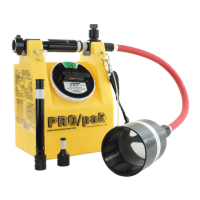©Copyright Task Force Tips LLC 2003-2020 2 LIU-030 August 24, 2020 Rev10
TABLE OF CONTENTS
1.0 MEANING OF SAFETY SIGNAL WORDS
2.0 SAFETY
3.0 GENERAL INFORMATION
3.1 SPECIFICATIONS
3.2 PART IDENTIFICATION
3.3 LEFT OR RIGHT HAND OPERATION
3.4 DILUTION EQUIVALENTS
4.0 FLOW CHARACTERISTICS
5.0 FOAM SELECTION
5.1 USING FOAM
5.2 AGENT COMPATIBILITY
6.0 NOZZLE SELECTION
7.0 OPERATION
7.1 HOSE CONNECTION
7.2 FILLING THE TANK
7.3 CONNECTING DISCHARGE HOSE AND NOZZLE
7.4 SETTING CONCENTRATION
7.5 CONTROLLING FLOW
7.6 FOAM QUALITY
7.7 SHUT DOWN AFTER USE (FLUSHING)
7.8 STORAGE
8.0 WARRANTY
9.0 TROUBLESHOOTING
10.0 CLEAN UP AND MAINTENANCE
10.1 DRAIN HOLE
11.0 DRAWINGS AND PART LISTS
This Operator Manual is not intended as a substitute for proper training in the use of equipment as taught from credible
sources such as the National Fire Protection Association (NFPA), The International Fire Service Training Association (IFSTA),
or sources approved by the Authority Having Jurisdiction (AHJ).
Examples of recent publications:
NFPA 1145 - Guide for the Use of
Class A Foams in Fire Fighting
IFSTA Principles of
Foam Fire Fighting
DANGER
PERSONAL RESPONSIBILITY CODE
The member companies of FEMSA that provide emergency response
equipment and services want responders to know and understand the
following:
1. Fire¿ ghting and Emergency Response are inherently dangerous activities
requiring proper training in their hazards and the use of extreme caution
at all times.
2. It is your responsibility to read and understand any user’s instructions,
including purpose and limitations, provided with any piece of equipment
you may be called upon to use.
3. It is your responsibility to know that you have been properly trained in
Fire¿ ghting and /or Emergency Response and in the use, precautions, and
care of any equipment you may be called upon to use.
4. It is your responsibility to be in proper physical condition and to maintain
the personal skill level required to operate any equipment you may be
called upon to use.
5. It is your responsibility to know that your equipment is in operable
condition and has been maintained in accordance with the manufacturer’s
instructions.
6. Failure to follow these guidelines may result in death, burns or other
severe injury.
FEMSA
Fire and Emergency Manufacturers and Service Association
P.O. Box 147, Lynn¿ eld, MA 01940 • www.FEMSA.org

